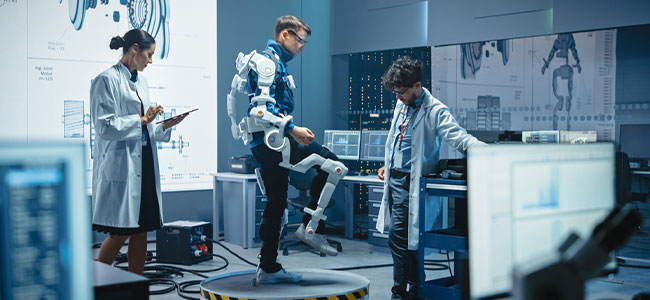
Creating a More Sustainable Future Workforce Through Exosuits and Human Augmentation
Exoskeletons, once only seen in the realm of science fiction, have broken into our workplaces with a promise of a safer, more efficient and sustainable future of work.
- By Armin G. Schmidt
- Nov 17, 2023
Businesses in industries and critical infrastructures that rely on manual handling are facing severe labor shortages, made even more challenging as workers age or fall out of the labor force on a temporary or permanent basis due to injury. According to the World Health Organization (WHO), musculoskeletal disorders (MSDs) affect around 1.71 billion people globally and are the leading contributor to disability worldwide, with low back pain being the single biggest cause.
Repeated heavy lifting is an activity that places considerable strain on the musculoskeletal system, which can lead to the development of MSDs. The Center for Disease Control (CDC) cites that US companies spend$50 billion on the direct costs of MSDs – with indirect costs amounting up to five times this amount, according to OSHA figures. And as populations continue to age, these figures will rise. Smart wearables and exosuits can be an answer to address these challenges.
Exoskeletons, once only seen in the realm of science fiction, have broken into our workplaces with a promise of a safer, more efficient and sustainable future of work. These innovative wearable devices are not just transforming industries; they’re empowering employees and making the companies deploying them stand out as more attractive places to work. Among exoskeletons, it’s the active (powered) types that are emerging as the most effective solutions when it comes to providing support for the lower back in heavy-lifting work environments.
Symbols of Forward-Thinking Workplaces
Exoskeletons are fast becoming symbols of forward-thinking workplaces. Beyond revolutionizing workplace safety, smart and connected devices offer a multifaceted approach to creating a more sustainable workforce, one where employees are safer, healthier, happier and more productive.
Imagine manual handling workspaces where physical strain and injury risks are drastically reduced, where repetitive tasks are made lighter and where every employee is equipped to excel. This vision is becoming a reality, with exosuits poised to become indispensable assets in our evolving work landscape. This would make physical work in such work environments more appealing, thereby helping to attract and retain workers in jobs that are characteristically system-critical.
Active Assistance and Dynamic Adaptation
Among exoskeletons designed to support the lower back, it is active, connected exoskeletons that are leading the innovation charge. Unlike passive exoskeletons which rely solely on the energy provided by the wearer—which is stored within their mechanical components, like springs—active systems incorporate battery-powered motors to provide wearers with additional energy for support in tasks such as repetitive heavy lifting, walking or working in unergonomic, bent-over postures. Another key benefit is their ability to respond dynamically to the wearer’s movements. Smart, active exoskeletons can sense changes in posture, exertion or levels of fatigue and can consequently provide additional energy when it’s needed most. This surge of mechanical power at precisely the moment it is required is a game-changer, as it actively collaborates with the wearer, amplifying their capabilities.
Building Trust and Acceptance
Successful integration of exoskeletons into the workplace starts with transparent communication about the goals and benefits of their introduction as well as a carefully planned onboarding process. Also crucial is the presence of open channels of communication that allow for questions from the workers to be answered, potential fears to be allayed and for valuable feedback to be heard regarding the implementation of the devices. All these factors contribute to managing expectations and driving long-term acceptance.
Empowering Tomorrow’s Workforce
Embracing these innovations isn’t just about improving work; it’s about creating a sustainable, safe and supportive future of work. And according to figures from ABI Research, global revenues in the field are projected to exceed $7 billion by 2030, with active exoskeletons leading the growth, potentially doubling revenue compared to passive devices. As such, this form of human augmentation will continue to rapidly evolve, and exoskeletons are set to become an increasing part of our lives in the future.